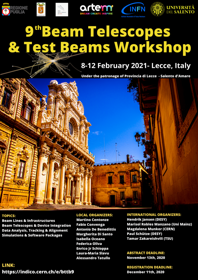Speaker
Description
In order to cope with the occupancy and radiation doses expected at the High-Luminosity LHC, the ATLAS experiment will replace its Inner Detector with an all-silicon Inner Tracker (ITk), containing pixel and strip subsystems. The strip subsystem will be built from modules, consisting of one n+-in-p silicon sensor, one or two PCB hybrids containing the front-end electronics, and one powerboard with high voltage, low voltage, and monitoring electronics. The sensors in the central region of the detector will use a simple rectangular geometry, while those in the forward region will use a radial geometry with built-in stereo angle.
To validate the expected performance of the ITk strip detector, a series of testbeam campaigns has been performed over several years at the DESY-II testbeam facility. Tracking was provided by EUDET telescopes, consisting of six Mimosa26 pixel planes. An additional pixel or strip plane was used to improve the timing resolution of the telescope. Tracks are reconstructed using the General Broken Lines algorithm, resulting in a spatial resolution of several microns.
This contribution will summarize the main results of these campaigns, including tracking performance and detector efficiency after irradiation. The data have been reconstructed using both the EUTelescope and Corryvreckan frameworks, and a comparison between the two will be shown. The results are also compared to predictions from simulation done with the Allpix-squared framework. Finally, a comparison has been made of the performance of several different timing planes, with implications for future testbeam campaigns.
